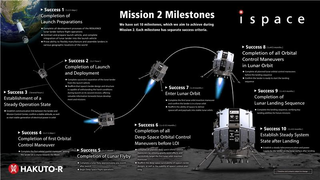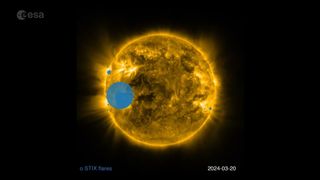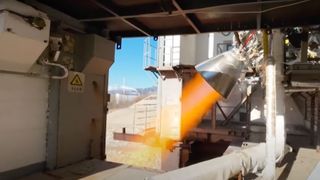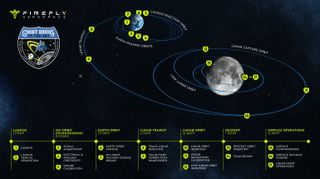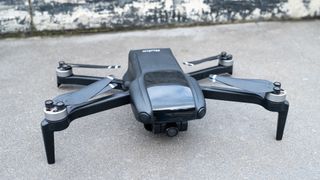Japanese space exploration company ispace is all set to launch its second lunar lander early Wednesday morning (Jan. 15), but what will the spacecraft carry with it to the moon? The ispace Resilience lander will lift off atop of a SpaceX Falcon 9 rocket from Launch Complex 39A at NASA’s Kennedy Space Center in Florida Wednesday at 1:11 a.m. EST (0611 GMT), with Firefly Aerospace’s Blue Ghost lunar lander also on the flight. The dual moon mission is the first of an array of lunar launches planned for 2025. Resilience…
Read MoreCategory: Solar System
Our solar system
Scientists turn 3 years’ worth of solar flares into audible sound (video)
If you’re more of an auditory learner than a visual one, this timelapse video is for you. (And, well, visual learners will probably love it, too!) The European Space Agency (ESA) has released an audio-visual representation of solar activity over the last three years, pulling data from its Solar Orbiter probe, which it runs with NASA. In the video, we see blue circles popping up across the surface of the sun — and audible tones paired with each of these circles. As time progresses toward the present day, the frequency…
Read MoreTotal lunar eclipse March 2025: When and where to see the next ‘Blood Moon’ lunar eclipse
On the night of March 13-14, 2025, a total lunar eclipse will be visible from Earth, and North America will be in the prime position for the spectacular event, which will also feature a “Blood Moon.” Lunar eclipses happen when Earth is between the sun and a full moon. During the event, the moon moves through Earth’s umbra, the dark center of its shadow. Where will the March 13-14, 2025, total lunar eclipse be visible? The best views will be for those in North and South America. According to Time…
Read MoreThe 2025 ‘Super Bowl of Astronomy’ kicks off this week in Maryland
Thousands of scientists from around the world are gathered in Maryland this week to discuss new discoveries about the universe and the latest astronomical advancements during the so-called “Super Bowl of astronomy.” The 245th Meeting of the American Astronomical Society, running Jan. 12 to Jan. 16, will feature many of the remarkable findings from the James Webb Space Telescope (JWST), which began observing the cosmos in 2022. The meeting is being held at the Gaylord National Resort & Convention Center in National Harbor, Maryland. The four-day conference will include presentations…
Read MoreChina test-fires 5 new rocket engines in a single day. But what are they for? (video)
China’s state-owned main space contractor tested five different rocket engines on one day last week in preparation for future missions and projects. The China Aerospace Science and Technology Corporation (CASC) tested the engines at two sites in Beijing and Laiyuan County in Hebei Province, north China, on Jan. 2. One test-fired a new hydrogen-oxygen engine for the upper stage of an unspecified rocket for 100 seconds. It was conducted by the 101 Institute of CASC’s Academy of Aerospace Propulsion Technology. On Jan. 2, 2025, China tested five new rocket engines,…
Read MoreSpaceX will launch 2 private lunar landers this week, kicking off busy year for moon missions
Two private lunar landers are set to launch this week aboard the same rocket, kicking off a busy year of missions to the moon. A six-day window for the SpaceX Falcon 9 rocket launching the missions begins early Wednesday morning (Jan. 15), with liftoff scheduled for 1:11 a.m. EST (0611 GMT) from Launch Complex-39B at NASA’s Kennedy Space Center (KSC) in Florida. The Falcon 9 will carry both landers to Earth orbit, where each will begin independent trajectories toward the moon. Ghost Riders in the Sky, the mission for Firefly…
Read MoreSmart robot helps out astronauts on China’s Tiangong space station (video)
Astronauts aboard China’s Tiangong space station have been getting some assistance from an “intelligent” robot. Cai Xuzhe, Song Lingdong and Wang Haoze — the crew of the current Shenzhou 19 mission aboard Tiangong — have been working alongside a robot named Xiao Hang (“Little Space”) using human-robot collaborative interaction software. The software has allowed them to carry out a variety of experiments related to human-robot spatial relationships, robot behavior characterization and multimodal interaction technologies. The goal of these experiments is to help enhance mission efficiency by fostering a more effective…
Read MoreRuko U11MINI drone review
Ruko drones are popular options for beginners, and the Ruko U11MINI is a sub-250 g model that weighs just 8.29 oz / 235 g — one of the lighter drones in this popular category. With some impressive drones released in 2024, the U11MINI does not qualify as one of the best beginner drones because competition in this category has seriously heated up, but it remains an option to consider. Key Specs Weight: 8.29 oz / 235 g Dimensions: 5.55×3.42×2.44 in / 141x87x62 mm folded / 12.71×10.67×2.44 in / 323x271x62 mm…
Read More‘Dune: Prophecy’ showrunner and Harkonnen stars dissect a stellar first season (exclusive)
HBO’s “Dune: Prophecy” aired its eventful season finale on Dec. 22, right before Christmas bells rang, and it was a satisfying end to this spinoff series set 10,000 years before Paul Atreides’ birth and concerned the rise of the Bene Gesserit sect. With the Sisterhood’s thinking machine smashed to bits, Emperor Corrino putting himself out of his misery, Tula embracing her enhanced son Desmond Hart, and Valya finally touching down on Arrakis in the sixth episode titled “The High-Handed Enemy,” many loose narrative ends and inevitable fates were all tied…
Read MoreWhat time is SpaceX’s Starship Flight 7 launch test on Jan. 13?
SpaceX is ready to launch its first Starship flight of 2025, a mission that will test a new version of the world’s largest rocket. But if you’re hoping to watch the planned Jan. 13 launch live online, you’ll need to know when and where, and for that we’ve got you covered. After a successful fueling test late Friday, Jan. 10, SpaceX is on track to launch its Starship Flight 7 mission at 5 p.m. EST (2200 GMT) on Monday, Jan. 13, from the company’s Starbase facility near Boca Chica Beach…
Read More